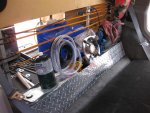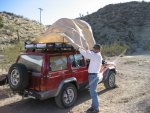More Jeep pictures
I guess the way to fill out this post is to, from time to time, post pictures of places or features. The picture below is a feature. The picture is taken thru the passenger side rear XJ door (it's a 4 door) looking back into the rear volume with the top of the rear bench seat folded forward. Normally in this view you would just see the empty cavity. In my jeep you are looking at the frontward end (but really the back of) the structure that holds the frig, drawers, and shelves.
The feature to be noticed is the tool and spare parts. The back of my drawers/shelves is vertical, but the back of the bench seat is not. The seat leans backwards. So there is a small triangular cavity. The picture shows that I've made use of this limited space by making aluminum boxes that just fit. These hold a fair number of tools and a bunch of spare parts such as duct tape, siphon hose, and other incidentals.
These came in really handy last summer in Colorado. My front axle smashed a transmission cooler line during articulation on a tough trail. I managed a field repair from these boxes using a rubber fuel hose splint and a couple of hose clamps. It's worked so well it is still there!

Thanks!
I guess the way to fill out this post is to, from time to time, post pictures of places or features. The picture below is a feature. The picture is taken thru the passenger side rear XJ door (it's a 4 door) looking back into the rear volume with the top of the rear bench seat folded forward. Normally in this view you would just see the empty cavity. In my jeep you are looking at the frontward end (but really the back of) the structure that holds the frig, drawers, and shelves.
The feature to be noticed is the tool and spare parts. The back of my drawers/shelves is vertical, but the back of the bench seat is not. The seat leans backwards. So there is a small triangular cavity. The picture shows that I've made use of this limited space by making aluminum boxes that just fit. These hold a fair number of tools and a bunch of spare parts such as duct tape, siphon hose, and other incidentals.
These came in really handy last summer in Colorado. My front axle smashed a transmission cooler line during articulation on a tough trail. I managed a field repair from these boxes using a rubber fuel hose splint and a couple of hose clamps. It's worked so well it is still there!
Thanks!
Attachments
Last edited:









